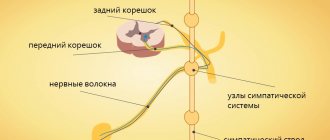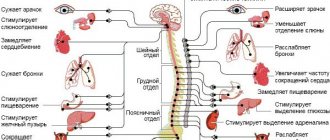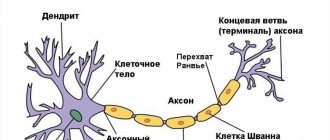Features of the nervous system
The psyche and body of the adze are interconnected. Any change in one system leads to changes in another. All this is reflected in the internal state. In neurology there is a separate direction - psychosomatics, with the help of which it is possible to establish a certain connection between mental reactions and their impact on human physiology.
As soon as a person becomes depressed or experiences stress, a protective reaction of the body immediately occurs - muscle tension. The body is constantly in tension, while the soul calms down. If such situations happen very rarely, then nothing harms the body.
But if this becomes regular, a psychosomatic illness may appear, which is difficult to identify. Physical ailments begin to actively manifest themselves, and the psychological causes are “deeply” hidden. As a result, doctors can spend years eliminating the effects without knowing exactly the main cause.
All processes inside the body occur smoothly and smoothly, controlled by the central nervous system. But if there is a chronic focus of excitation in the brain, which is caused by negative emotions, the nervous system no longer performs its main function.
When the body is left without a commander-in-chief, failures gradually occur that lead to the collapse of the unified system. The work of every organ is disrupted. As a result, a person develops diseases of the heart, stomach, etc. In addition, other ailments appear: poor appetite, insomnia, apathy, irritation, lack of interest in what is happening and in one’s life. In addition to the body, the psyche suffers. A feeling of anxiety and restlessness appears. From this observation it is clear why the nerves and psyche need to be strengthened. There are a huge number of special techniques for this, which are divided into 2 main groups: for the psyche and the body.
The use of B vitamins in neurological practice
TREATMENT WITH GROUP B VITAMINS
The proven effectiveness of the use of B vitamins in the treatment of chronic back pain is characterized by a decrease in pain syndrome (analgesic effect). With the neuropathic nature of pain, the targets for vitamins are pain receptors and sodium channels of damaged nerve fibers. In the largest clinical study, intramuscular administration of B vitamins, together with basic therapy with nonsteroidal anti-inflammatory drugs (NSAIDs), noted a significant reduction in pain, as well as normalization of motor function. This is due to the fact that such combination therapy is easily tolerated by patients; vitamins enhance and prolong the effect of NSAIDs (this allows the dose of the latter to be reduced to avoid side effects of the drugs). (Mauro, Martorana, et al. Vitamin B12 in low back pain: a randomized, double –blind, placebo–controlled study – 2000).
The use of vitamins to correct polyneuropathy (caused by the consequences of diabetes mellitus or chronic alcohol intoxication) is also justified from the point of view of evidence-based medicine. Their use reliably reduces the intensity of pain, reducing the feeling of burning, coldness, numbness and other subjective disorders. (Talaei, Siavash, et al. Vitamin B12 may be more effective in improving painful diabetic neuropathy - 2009).
The positive effect of taking pyridoxine (vitamin B6) in the treatment of drug-resistant forms of epilepsy and early-onset epilepsy has been proven. Together with the main therapy with antiepileptic drugs, vitamins potentiate their effect and reduce the severity of side effects, which makes it possible to reduce the frequency and activity of attacks or stop them completely (Huei-Shyong, Meng-Fai, Vitamin B6 related epilepsy during childhood - 2007).
Recently, the use of B vitamin preparations for the treatment and prevention of cerebrovascular diseases and their complications has been actively studied. Complex vitamin therapy helps reduce the level of serum homocysteine, which is one of the common risk factors for the development of vascular accidents. (Mccully, Vascular pathology of homocysteinemia: implications for the pathogenesis of homocysteinemia - 1969.).
Please note that this article is for informational purposes only and is not an indication for self-prescription of medications.
The article has been checked by the head. department, neurologist, neurophysiologist, ultrasound diagnostic doctor, specialist of the highest qualification category, work experience of more than 17 years. Gaponova Olga Vladimirovna
Body strengthening
To restore your body and mind, you need to follow simple tips:
- Physical activity has a positive effect on the body. Constant movement, sports and other physical activity have a positive effect on the condition of the body, and, consequently, the nervous system improves;
- control your diet. The body must receive the required amount of vitamins, minerals and other beneficial substances found in food products every day;
- rejection of bad habits. Despite the fact that many are accustomed to starting the morning with coffee and a cigarette, this habit should be forgotten. It’s better to completely give up all bad habits, such as alcohol, cigarettes, stimulants. The excitement that occurs due to receiving a dose of nicotine is quickly replaced by an inhibitory reaction;
- sauna and bathhouse. Such methods help cleanse the body and soul. Elevated temperatures and hot steam together help cope with many diseases, the body and nerves relax;
- harden. Water has a positive effect on the nervous system. If you harden yourself, you can strengthen your immune system. It invigorates and strengthens the body. There is a more extreme way to harden yourself - winter swimming. It may seem strange, but the health and calmness of walruses can only be envied. If you go down into an ice hole, your body will be very grateful;
- drink as much water as possible. Many people know the 8 glasses method. This is how much water a person should drink per day. This cleanses the body well, removing toxic substances;
- massage. A great way to get rid of many ailments and relieve stress. The body gradually loses its flexibility, the joints become less mobile. A good massage will speed up blood circulation and trigger metabolic processes.
Proper diet
Nutritionists have developed a special diet for those who want to stop being nervous and start enjoying life. If the body lacks potassium, calcium, magnesium, phosphorus and iron, then the nervous system and the entire body will suffer. It is especially important to ensure that the body receives the required amount of magnesium.
- You need to eat buckwheat, oat and wheat porridge more often.
- Phosphorus relieves muscle tension and stabilizes the functioning of the nervous system. The trace element is present in milk, cereals and beans.
- Calcium – regulates the functioning of muscles and nerves. Contained in milk, nuts and cabbage.
- Iron – contributes to the normal functioning of the thyroid gland, ensures normal metabolic processes. Present in seafood, river fish, fruits, green vegetables, baked goods.
- Potassium – normalizes the smooth functioning of nerves and muscles, prevents stress and nervous breakdowns. The lack of microelements can be compensated for by vegetables, fruits, lean meat and fish, and dried fruits.
Does vitamin C affect neurodegenerative diseases and mental disorders?
Vitamin C (Vit C) is considered a vital antioxidant molecule in the brain. Intracellular Vit C helps maintain the integrity and function of several processes in the central nervous system (CNS), including neuronal maturation and differentiation, myelin formation, catecholamine synthesis, modulation of neurotransmission, and antioxidant defense. The importance of Vit C for central nervous system function has been demonstrated by the fact that targeted deletion of the sodium-vitamin C co-transporter results in widespread cerebral hemorrhage and death on the first day after birth. Since neurological diseases are characterized by increased production of free radicals, and the highest concentrations of Vit C in the body are found in the brain and neuroendocrine tissues, it is hypothesized that vitamin C may modify the course of neurological and psychiatric diseases and have potential therapeutic efficacy in their treatment.
Vitamin C (Vit C, ascorbic acid) belongs to the group of water-soluble vitamins. In organisms, Vit C can exist in two forms: reduced - exact ascorbic acid (AA), which at physiological pH occurs in the form of ascorbate anion - and oxidized - dehydroascorbic acid (DHA), which is a product of two-electron oxidation of AA. During metabolic processes, ascorbate free radical can be formed as a result of one-electron oxidation. This radical can subsequently undergo dismutation to form ascorbate and DHA.
Mammalian organisms are generally capable of independently synthesizing vitamin C. However, some species, particularly primates and humans, lack this ability due to the absence of the enzyme 1-gulono-1,4-lactone oxidase, which is an element of the metabolic pathway responsible for the synthesis ascorbic acid from glucose. In addition, Vit C is not produced by intestinal microflora.
The recommended daily intake of vitamin C has been set at 60 mg, with the caveat that this value should be increased to 140 mg in smokers. More recent recommendations suggest that vitamin C intake should be 75 (women) and 90 (men) mg per day, while this value should be increased by 35 mg per day for smokers.
Vitamin C is a nutrient essential for the proper functioning of the nervous system, and its main role in the brain is its participation in antioxidant defense. In addition to this role, it is involved in numerous non-oxidative processes, such as the biosynthesis of the hormones collagen, carnitine, tyrosine and peptides, as well as myelin. It plays a critical role in neurotransmission and neuronal maturation and function. For example, it has been shown to reduce the severity of epileptic seizures, as well as reduce brain damage caused by seizures. On the other hand, impaired vitamin C transport has been shown to contribute to brain damage in premature infants. Additionally, Vit C treatment has been reported to improve neurodegenerative changes as well as memory impairment.
Two major barriers limit the entry of vitamin C (which is a hydrophilic molecule) into the central nervous system: the blood-brain barrier and the cerebrospinal fluid (CSF). In terms of the whole body, ascorbic acid uptake is primarily mediated by two sodium-dependent transporters from the SLC23 family, sodium-dependent Vit C transporter type 1 (SVCT1) and type 2 (SVCT2). They have a similar structure and amino acid sequence, but have different tissue distributions. SVCT1 is found predominantly in the apical limiting membranes of intestinal and renal tubular cells, whereas SVCT2 is found in most cellular tissues. SVCT2 is particularly important for Vit C transport in the brain—it mediates the transport of ascorbate from plasma through the choroid plexus into the cerebrospinal fluid and across the plasma membrane of neuronal cells into the neuronal cytosol. Although dehydroascorbic acid (DHA) penetrates the central nervous system more quickly than ascorbate, the latter readily enters the CNS after oral administration. DHA is taken up by glucose transporters (GLUTs), which have an affinity for this form of Vit C. GLUT1 and GLUT3 are mainly responsible for the uptake of DHA in the CNS. Transport of DHA by the GLUT transporter is bidirectional—every DHA molecule formed in cells by ascorbate oxidation can be lost. This phenomenon is prevented by efficient cellular mechanisms for the restoration and recycling of DHA in ascorbate. Neurons can take up ascorbic acid using both of the described pathways, whereas astrocytes acquire Vit C using only GLUT transporters.
The brain has been found to be among the organs with the highest ascorbate content, with neurons showing the highest concentration of ascorbate in the entire body, reaching 10 mmol/L. Milby et al. back in 1982, they showed the presence of high concentrations of Vit C in neuron-rich areas of the hippocampus and neocortex of the human brain. The authors suggested that ascorbate levels in these brain regions were twice as high as in other regions. The difference in ascorbate content between neurons and glia appears to be significant. It is suggested that in astrocytes and glial cells lacking SVCT2, DHA uptake and reduction may be the only mechanism for ascorbate retention. In addition to ascorbate movement in neurons and glial cells, it is also released from both cell types. This release contributes to a certain extent to the homeostatic mechanism of extracellular ascorbate in the brain. In addition, the concentration of extracellular ascorbate is dynamically regulated by the release of glutamate—increasing the concentration of extracellular Vit C causes heteroexchange with glutamate.
Functions of ascorbic acid in the central nervous system
It is known that the main function of intracellular ascorbic acid in the brain is antioxidant protection of cells . However, vitamin C in the central nervous system (CNS) also has many non-antioxidant functions - it plays the role of an enzymatic cofactor involved in the biosynthesis of substances such as collagen, carnitine, tyrosine and peptide hormones. It has also been indicated that the formation of myelin in Schwann cells can be stimulated ascorbic acid. Let us remind the Blog reader that the brain is an organ particularly susceptible to oxidative stress and free radical activity, which is associated with high levels of unsaturated fatty acids and a high cellular metabolic rate. Ascorbic acid, being an antioxidant, acts directly by removing reactive oxygen and nitrogen species formed during normal cellular metabolism. In vivo studies have shown that ascorbate has the ability to inactivate superoxide radicals, a major byproduct of the rapid metabolism of mitochondrial neurons. In addition, ascorbate is a key factor in the processing of other antioxidants, such as alpha-tocopherol (vitamin E). Alpha-tocopherol, found in all biological membranes, is involved in the prevention of lipid peroxidation by scavenging peroxyl radicals. During this process, α-tocopherol is oxidized to the α-tocopheroxy radical, which can lead to very negative effects. Ascorbate can reduce the tocopheroxy radical back to tocopherol, and its oxidized form is then recycled by enzymatic systems using NADH or NADPH. Thus, vitamin C is considered an important neuroprotective agent.
One important non-antioxidant function of vitamin C is its involvement in CNS signaling through neurotransmitters. Vit C is thought to influence this process by modulating the binding of neurotransmitters to receptors as well as regulating their release. In addition, ascorbic acid acts as a cofactor in the synthesis of neurotransmitters, in particular the catecholamines dopamine and norepinephrine.
Seitz et al. (1998) suggested that the modulatory effect of ascorbate can be divided into short-term and long-term. The short-term effect relates to the role of ascorbate as a substrate for dopamine β-hydroxylase. Vit C supplies electrons for this enzyme, which catalyzes the formation of norepinephrine from dopamine. Moreover, it may have a neuroprotective effect on ROS and quinones produced by dopamine metabolism. Alternatively, the long-term effect may be due to increased tyrosine hydroxylase gene expression, likely through a mechanism that entails an increase in intracellular cAMP. It has been established that the function of ascorbic acid as a neuromodulator of neuronal transmission may also be associated with a decrease in amino acid residues or the removal of ROS generated in response to activation of the neurotransmitter receptor. Moreover, some studies have shown that ascorbic acid modulates the activity of certain receptors such as glutamate as well as γ-aminobutyric acid (GABA). Vitamin C has been shown to be able to prevent excitotoxic damage caused by excessive extracellular glutamate leading to hyperpolarization of N-methyl-d-aspartate (NMDA) receptors and hence neuronal damage. Vit C inhibits the binding of glutamate to the NMDA receptor, thus demonstrating a direct effect in preventing excessive neural stimulation provided by glutamate. The effect of ascorbic acid on GABA receptors can be explained by the decrease in the energy barrier to GABA activation caused by this agent. Ascorbic acid can bind or modify one or more sites capable of allosterically modulating single-channel properties. It is also possible that ascorbic acid acts to support the transition from the last closed state associated with GABA to the open state. Alternatively, ascorbic acid may induce channel transitions to additional open states in which the receptor adopts lower energy conformations with a higher probability of opening.
There have also been reports of the effects of Vit C on cognitive processes such as learning, memory and locomotion, although the exact mechanism of these effects is still being studied. However, animal studies have shown a clear connection between ascorbate and the cholinergic and dopaminergic systems, and they have also suggested that ascorbate may act as a dopamine receptor antagonist. This was also confirmed by Tolbert et al. (1992), who showed that ascorbate inhibits the binding of specific dopamine D1 and D2 receptor agonists.
Another non-antioxidant function of Vit C involves modulating neuronal metabolism by altering the preference for lactate over glucose as an energy substrate to maintain synaptic activity. During the metabolic switch of ascorbic acid, this vitamin is released from glial cells and taken up by neurons, where it limits glucose transport and utilization. This allows lactate to be absorbed and used as the main source of energy in neurons. Intracellular ascorbic acid has been noted to inhibit neuronal glucose utilization through a mechanism involving GLUT3.
Vitamin C is involved in collagen synthesis, which also occurs in the brain. There is no doubt that collagen is essential for blood vessels and the formation of the lining of neurons. It is well known that vitamin C is involved in the final stage of the formation of mature triple helix collagen.









